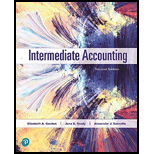
Intermediate Accounting (2nd Edition)
2nd Edition
ISBN: 9780134730370
Author: Elizabeth A. Gordon, Jana S. Raedy, Alexander J. Sannella
Publisher: PEARSON
expand_more
expand_more
format_list_bulleted
Textbook Question
Chapter 3, Problem 3.1E
Exercises
E3-1. Accounting Policy Disclosures. To compare entities in the same industry, it is important to determine the accounting methods used by each firm. Answer the following questions regarding accounting methods.
- a. Where do firms provide information about their accounting methods?
- b. Provide at least two examples of the accounting methods commonly covered in your first accounting course.
Expert Solution & Answer
Want to see the full answer?
Check out a sample textbook solution
Students have asked these similar questions
None
Subject: general Accounting
How much will you accumulated after 35 year?
Chapter 3 Solutions
Intermediate Accounting (2nd Edition)
Ch. 3 - Prob. 3.1QCh. 3 - Prob. 3.2QCh. 3 - Does U.S. GAAP require that companies disclose...Ch. 3 - Does IFRS require that companies disclose...Ch. 3 - Prob. 3.5QCh. 3 - Does IFRS require that companies disclose their...Ch. 3 - Prob. 3.7QCh. 3 - Prob. 3.8QCh. 3 - Prob. 3.9QCh. 3 - Prob. 3.10Q
Ch. 3 - Prob. 3.11QCh. 3 - What is the Basis for Conclusions and where can...Ch. 3 - Prob. 3.13QCh. 3 - Prob. 3.14QCh. 3 - Prob. 3.1BECh. 3 - Judgment in Accounting for Plant and Equipment....Ch. 3 - Match Each Cognitive Bias Below with its...Ch. 3 - Prob. 3.4BECh. 3 - Prob. 3.5BECh. 3 - Prob. 3.6BECh. 3 - Prob. 3.7BECh. 3 - Codification Research. Referencing Appendix A,...Ch. 3 - Prob. 3.9BECh. 3 - Prob. 3.10BECh. 3 - Exercises E3-1. Accounting Policy Disclosures. To...Ch. 3 - Cognitive Bias. A team of accounting students is...Ch. 3 - Cognitive Bias. A team of accounting students is...Ch. 3 - Authoritative Literature. Provide the reference to...Ch. 3 - Authoritative Literature. Provide the reference to...Ch. 3 - Authoritative Literature. To what entity types...Ch. 3 - Authoritative Literature. How does FASB define...Ch. 3 - Prob. 3.8ECh. 3 - Prob. 1JCCh. 3 - Prob. 2JCCh. 3 - Prob. 1SSCCh. 3 - Surfing the Standards Case 2: Inventory...Ch. 3 - Basis for Conclusions Case 1: Judgment and...Ch. 3 - Basis for Conclusions Case 2: Income Statement or...
Knowledge Booster
Learn more about
Need a deep-dive on the concept behind this application? Look no further. Learn more about this topic, accounting and related others by exploring similar questions and additional content below.Similar questions
- On a particular date, FedEx has a stock price of $89.27 and an EPS of $7.11. Its competitor, UPS, had an EPS of $0.38. What would be the expected price of UPS stock on this date, if estimated using the method of comparables? A) $4.77 B) $7.16 C) $9.54 D) $10.50arrow_forwardHow much will you accumulated after 35 year? General accountingarrow_forwardGiven correct answer general Accountingarrow_forward
arrow_back_ios
SEE MORE QUESTIONS
arrow_forward_ios
Recommended textbooks for you
- Principles of Accounting Volume 1AccountingISBN:9781947172685Author:OpenStaxPublisher:OpenStax College
 Financial Accounting: The Impact on Decision Make...AccountingISBN:9781305654174Author:Gary A. Porter, Curtis L. NortonPublisher:Cengage Learning
Financial Accounting: The Impact on Decision Make...AccountingISBN:9781305654174Author:Gary A. Porter, Curtis L. NortonPublisher:Cengage Learning College Accounting, Chapters 1-27AccountingISBN:9781337794756Author:HEINTZ, James A.Publisher:Cengage Learning,
College Accounting, Chapters 1-27AccountingISBN:9781337794756Author:HEINTZ, James A.Publisher:Cengage Learning,  Intermediate Accounting: Reporting And AnalysisAccountingISBN:9781337788281Author:James M. Wahlen, Jefferson P. Jones, Donald PagachPublisher:Cengage Learning
Intermediate Accounting: Reporting And AnalysisAccountingISBN:9781337788281Author:James M. Wahlen, Jefferson P. Jones, Donald PagachPublisher:Cengage Learning Auditing: A Risk Based-Approach to Conducting a Q...AccountingISBN:9781305080577Author:Karla M Johnstone, Audrey A. Gramling, Larry E. RittenbergPublisher:South-Western College Pub
Auditing: A Risk Based-Approach to Conducting a Q...AccountingISBN:9781305080577Author:Karla M Johnstone, Audrey A. Gramling, Larry E. RittenbergPublisher:South-Western College Pub

Principles of Accounting Volume 1
Accounting
ISBN:9781947172685
Author:OpenStax
Publisher:OpenStax College

Financial Accounting: The Impact on Decision Make...
Accounting
ISBN:9781305654174
Author:Gary A. Porter, Curtis L. Norton
Publisher:Cengage Learning

College Accounting, Chapters 1-27
Accounting
ISBN:9781337794756
Author:HEINTZ, James A.
Publisher:Cengage Learning,

Intermediate Accounting: Reporting And Analysis
Accounting
ISBN:9781337788281
Author:James M. Wahlen, Jefferson P. Jones, Donald Pagach
Publisher:Cengage Learning

Auditing: A Risk Based-Approach to Conducting a Q...
Accounting
ISBN:9781305080577
Author:Karla M Johnstone, Audrey A. Gramling, Larry E. Rittenberg
Publisher:South-Western College Pub
ACCOUNTING BASICS: Debits and Credits Explained; Author: Accounting Stuff;https://www.youtube.com/watch?v=VhwZ9t2b3Zk;License: Standard Youtube License